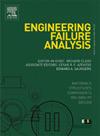The influence of friction block size on the tribological behavior of high-speed train brake interfaces in cold environments
IF 5.7
2区 工程技术
Q1 ENGINEERING, MECHANICAL
引用次数: 0
Abstract
High-speed train braking systems operate in open environments, making their performance vulnerable to external conditions. Under extreme cold, the braking interface undergoes complex tribological behaviors that can drastically reduce braking efficiency and pose risks to operational safety. In conventional service environments, optimizing the dimensions of brake pad friction blocks is considered an effective method to improve the frictional performance characteristics of the braking interface, the effects of block size in extreme cold conditions remain insufficiently explored. To investigate this, we designed four blocks of varying sizes and employed a high-speed train braking simulation device to examine their influence on friction, wear, braking performance, and noise in an extremely cold environment (−40 °C). The results indicate that under such conditions, the size of the block significantly affects the braking interface in terms of friction and wear, braking, and noise. Specifically, the block with small size exhibited minimal eccentric wear, introduced fewer wear debris into the braking interface, had a smaller contact platform area, and generated lower-intensity, less fluctuating friction-induced vibration and noise (FIVN). As the diameter of the block increased, eccentric wear intensified, leading to a higher amount of wear debris entering the braking interface. Additionally, a larger block diameter resulted in an increased frictional contact area, generating more frictional heat. The accumulated wear debris compacted to form a larger contact platform, which led to high-intensity FIVN. Compared to the continuous FIVN produced by the with small size, the other three block sizes exhibited intermittent FIVN. Overall, block size significantly influences the tribological behavior of the high-speed train braking interface in extremely cold environments. Therefore, block size must be a key consideration in the design of brake pads for operation in extremely cold environments.
低温环境下摩擦块尺寸对高速列车制动界面摩擦学性能的影响
高速列车制动系统在开放环境中运行,使其性能容易受到外部条件的影响。在极冷条件下,制动界面会经历复杂的摩擦学行为,这可能会大大降低制动效率,并对操作安全构成威胁。在常规使用环境下,优化刹车片摩擦块尺寸被认为是改善制动界面摩擦性能特性的有效方法,但在极端寒冷条件下,摩擦块尺寸对制动界面摩擦性能的影响尚未得到充分探讨。为了研究这一点,我们设计了四个不同尺寸的块,并采用高速列车制动模拟装置来研究它们在极冷环境(- 40°C)下对摩擦、磨损、制动性能和噪声的影响。结果表明,在此工况下,挡块尺寸对制动界面的摩擦磨损、制动性能和噪声影响显著。具体而言,小尺寸的块体偏心磨损最小,在制动界面引入的磨损碎片较少,接触平台面积较小,产生的强度更低,波动摩擦引起的振动和噪声(FIVN)更小。随着块体直径的增大,偏心磨损加剧,导致进入制动界面的磨损碎片量增加。此外,较大的块直径导致摩擦接触面积增加,产生更多的摩擦热。堆积的磨损碎屑压实形成更大的接触平台,导致高强度fiv。与小尺寸块体产生的连续FIVN相比,其他三种块体大小表现为间歇性FIVN。总体而言,在极冷环境下,块尺寸显著影响高速列车制动界面的摩擦学行为。因此,在设计极寒环境下运行的刹车片时,块尺寸必须是一个关键的考虑因素。
本文章由计算机程序翻译,如有差异,请以英文原文为准。
求助全文
约1分钟内获得全文
求助全文
来源期刊

Engineering Failure Analysis
工程技术-材料科学:表征与测试
CiteScore
7.70
自引率
20.00%
发文量
956
审稿时长
47 days
期刊介绍:
Engineering Failure Analysis publishes research papers describing the analysis of engineering failures and related studies.
Papers relating to the structure, properties and behaviour of engineering materials are encouraged, particularly those which also involve the detailed application of materials parameters to problems in engineering structures, components and design. In addition to the area of materials engineering, the interacting fields of mechanical, manufacturing, aeronautical, civil, chemical, corrosion and design engineering are considered relevant. Activity should be directed at analysing engineering failures and carrying out research to help reduce the incidences of failures and to extend the operating horizons of engineering materials.
Emphasis is placed on the mechanical properties of materials and their behaviour when influenced by structure, process and environment. Metallic, polymeric, ceramic and natural materials are all included and the application of these materials to real engineering situations should be emphasised. The use of a case-study based approach is also encouraged.
Engineering Failure Analysis provides essential reference material and critical feedback into the design process thereby contributing to the prevention of engineering failures in the future. All submissions will be subject to peer review from leading experts in the field.
 求助内容:
求助内容: 应助结果提醒方式:
应助结果提醒方式:


